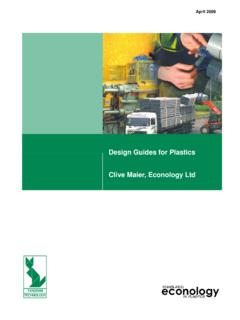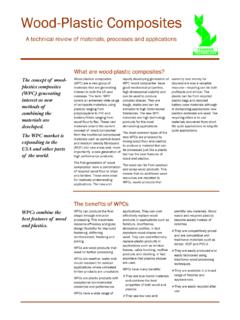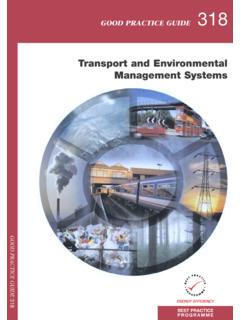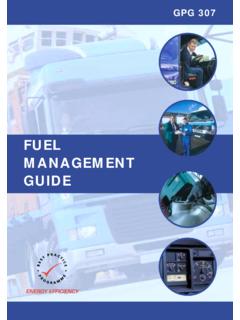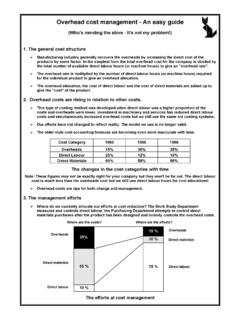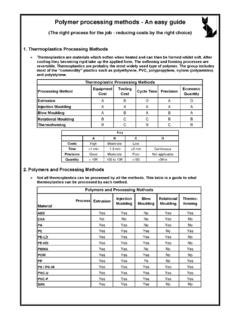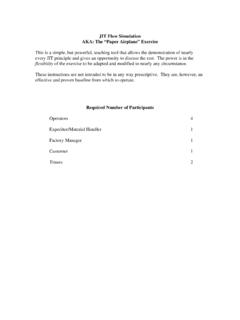Transcription of Managing machinery safety in small plastics factories
1 IntroductionThis sheet was produced by the Health and SafetyExecutive (HSE) in consultation with the PlasticsProcessors Health and safety Liaison Committee(PPHSLC). This committee comprises HSE, employersand employee representatives in the plastics industry. Ithas been written for the owners and managers of smallplastics companies, but it may also be useful to largercompanies. It should be read alongside the relevantmanufacturing process sheets for your factory. This sheet explains why you need to actively managemachinery safety to prevent accidents and it describes asimple system for doing so. In using such a system youwill be complying with regulations 5 and 6 of theProvision and Use of Work Equipment Regulations 1998(PUWER 98) which relate to the maintenance andinspection of machinery do accidents happen at plastics machinery ?
2 In preparing these sheets, HSE has reviewed ten yearsof accident data from the plastics industry. From thisanalysis, three major causes stand out: inadequate safeguarding fitted; the safeguarding had been removed or fallen intodisrepair; or the safeguarding had been overridden, usually a result, the major injury rate for machinery accidentsin the plastics processing industry in 1997/98 was 65%higher than that for all manufacturing industry. Taken together, these three factors account for mostmajor injuries at plastics machinery . Three examplesfrom 1997/98 are quoted below and typify what can gowrong if machinery safety is not properly do I need to do?To prevent accidents like these in your own factory, youneed to assess the risks and address each of the threemain causes in turn, namely: provide the right safeguarding in the first place; check that this is kept in position and is workingeffectively; and make sure that safe systems of work are followed this may sound daunting for a small company withoutthe benefit of specialist staff, but the eight sheets listed inthe Introduction provide the conclusions of generic riskassessments for you.
3 Managing machinery safety in smallplastics factoriesPlastics Processing sheet No 3 Inadequate safeguarding fittedAn operator was feeding a haul-off with a newlyextruded run of plastic profile. The extrusion was hotand he was wearing gloves. When he presented theextrusion to the nip, the glove stuck to the plastic andhis hand was pulled into the nip. There was no guard atthe infeed to the unit, and he suffered a crushed handand broken overriddenA shift supervisor was trying to clear a blockage at thecutting station on an in-line thermoforming machine. Heopened the guard and expected the machine to stop, butthe interlock had been rendered inoperative by a setterearlier in the day while fault finding. As a result, thesupervisor lost two fingers and his hand was removed/in disrepairA fixed guard on a blow moulding machine was removedto clear product blockages and was not replaced.
4 Sometime later, on another shift, a university student doingholiday work had his hand crushed and tendons severedby the carriage mechanism when trying to clear Processing SheetsNo Process 4 Injection moulding 5 Blow moulding 6 Thermoforming 7 Extrusion/haul-off 8 Window frame manufacture 9 Compression moulding 10 Granulators 11 Reeling/winding They detail acceptable safeguarding requirements,contain checklists and describe safe setting procedureswhere specifications have been discussed and agreedwith industry representatives from the British PlasticsFederation (BPF), the Packaging and Industrial FilmsAssociation (PIFA) and the plastics machinery DistributorsAssociation (PMDA). The checklists build on proceduresand arrangements already in use within the 1 Compare the safeguarding standards on your ownmachines against those in the relevant process-specificsheet.
5 As a result of this, you may need to upgrade whatyou now have in position to currently acceptable standardsof safety . (These safeguarding improvements will notrequire existing machines to be CE-marked.)You will also need to consider whether the description inthe sheet adequately covers all the specifics of your example, you might have robot feeds, conveyorsystems or other customised features to take into account. Step 2 The process-specific sheets include two sets of first contains mainly visual and functional checks forthe operator to undertake (usually each day/shift). Theseshould only take a few minutes to complete and can beviewed as part of a start-up or handover operator s checklist has been written in a form suitablefor all machines of a given type, so it should first becustomised and simplified to make it more directly relevantto your plant.
6 Keep in only those features on your ownmachines. You should also add any extra detail specific toyour machinery (like the robots and conveyors mentionedabove), or from the manufacturer s PPHSLC recommends that these machine-specificchecklists are then attached to each machine, and thatoperators are expected to sign that they have completedthe check. The checklist will act as a reminder and willshow that the operator has an important role to play.(Some companies have also converted these lists intoschematic drawings to ease language difficulties.)The second checklist requires greater familiarity with theworkings of the machine and has been designed forcompletion by a setter or in-house maintenance PPHSLC recommends a check once a month atfirst, to be refined in the light of experience. For somemachines these will be inspections in terms of PUWER regulation 6(2).
7 This second checklist should also becustomised as described second set of checks could be staggered week byweek, so spreading the workload on the individuals concerned. Alternatively, if you have just a few machines,you may choose to carry out all the inspections on thesame day so that the task is seen to be done. Before any such systems are put in place it isessential that all the staff concerned are fully briefedon what they have to do, why they have to do it, andthat they will be accountable for this work. Mostimportantly however, you must explain what theyshould do when a defect is found. If, for whateverreason, you cannot trust certain staff to fulfil theseresponsibilities, then they should not be given thesetasks and you will need to make alternativearrangements. (You might choose to allocate theresponsibilities to a foreman/chargehand forinstance, or to a quality controller.)
8 Step 3 The process-specific sheets also contain guidance on thesafe setting of such machinery . You will need to comparethis against current practices on your own plant. As a result, you may discover you need to: provide extra facilities for safe setting (eg inch controls, handling aids or means of isolation); and/or develop customised safe systems of work with yoursetters for your own machinery . Is that everything?As the owner or manager of a small business you willalready be aware that your own contribution is veryimportant for getting things done in the factory. Yourpriorities and your attitudes set the tone for others to proactive management system described so far in thissheet will not take hold and will not be maintained unlessyou are seen to be fully behind it. The final componenttherefore is your own personal 4 There are many ways you can show your owncommitment to these arrangements, but the basiccomponents are: Involve yourself directly in setting up these into existing safeguarding standards staff yourself, or be present if someone else does.
9 Add a personal message of your own to set thetone. (You could say, for example, that you want toprotect the firm s good name.) Make a point of checking that your setters arefollowing the agreed safety procedures when youcome across them toolsetting. Check that your systems are in place and effectivewhen new employees start, new machines arrive orif any warning signs occur (such as a near-miss). Make a show of praising vigilance and will I know if we are Managing machinerysafety properly?The answer lies in what your own involvement at Step 4tells you. If you know that you have systems in place forchecking machinery safety using these sheets as yourguide, and if you have satisfied yourself that your staffare carrying out their duties conscientiously, then youcan be confident that you are Managing machinerysafety following case studies are from companies thatwere not doing so.
10 Could they be describing your owncompany now?Further readingSafe use of work equipment. Provision and Use of WorkEquipment Regulations 1998. Approved Code ofPractice and GuidanceL22 HSE Books 1998 ISBN 0 7176 1626 6 Further informationHSE priced and free publications are available by mailorder from HSE Books, PO Box 1999, Sudbury, SuffolkCO10 6FS. Tel: 01787 881165 Fax: 01787 priced publications are also available from goodbooksellers. For other enquiries ring HSE s InfoLine Tel: 0541 545500, or write to HSE's Information Centre,Broad Lane, Sheffield S3 home page on the World Wide Web: publication may be freely reproduced, except foradvertising, endorsement or commercial purposes. Theinformation is current at 6/99. Please acknowledge thesource as leaflet contains notes on good practice whichare not compulsory but which you may find helpfulin considering what you need to film winderAn accident occurred at a blown film line when anoperator was caught and trapped by the cross-cuttingdevice at the reel change.

